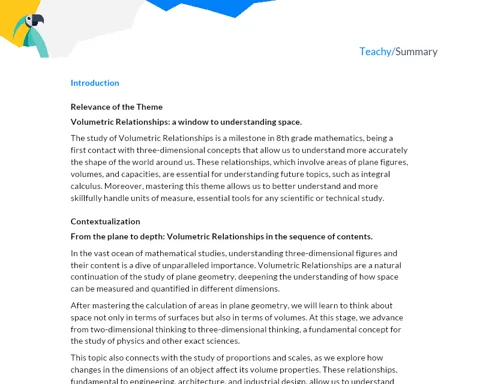Area of Shapes | Active Summary
Objectives
1. Develop skills to calculate the area of various flat figures such as quadrilaterals, triangles, and circles.
2. Apply area concepts in practical everyday situations, such as space planning or organizing materials on surfaces.
Contextualization
Did you know that the ability to calculate areas is not just a mathematical tool but also essential in many professions and everyday situations? From architects planning urban spaces to interior designers optimizing the use of every centimeter in an environment, area calculation is crucial. For example, when planning a park or a square, knowledge of areas ensures that projects are not only beautiful but also functional and safe, guaranteeing enough space for leisure and the preservation of green areas. These real-life examples show how the mathematics we learn in the classroom has significant practical applications in our world.
Important Topics
Quadrilaterals
Quadrilaterals are flat geometric figures composed of four sides. They can have sides of varying lengths and different angles. Calculating the area of a quadrilateral involves understanding that it can be divided into triangles and rectangles, making the total area calculation easier.
-
To calculate the area of a quadrilateral, we can use the general area formula A = base x height. If the quadrilateral is a parallelogram, we can use the height perpendicular to the base.
-
If the quadrilateral is any other type, it can be divided into smaller triangles and rectangles, whose areas are then summed to obtain the total area of the quadrilateral.
-
Common examples of quadrilaterals are rectangles, squares, trapezoids, and rhombuses, each with its own area calculation formulas.
Triangles
Triangles are polygons with three sides and three internal angles. Calculating the area of a triangle is fundamental in many practical applications, such as construction and design, as many figures can be approximated by triangles.
-
The area of a triangle can be calculated using the formula A = 0.5 x base x height, where the height is the perpendicular distance to a base.
-
There are different types of triangles (equilateral, isosceles, scalene), and the formula for calculating the area may vary depending on the type.
-
Triangles are often used to calculate areas of irregular terrains or to find the area of surfaces such as roofs or building facades.
Circles
Circles are flat figures defined by all points that are a fixed distance from a central point, called the center. The calculation of the area of a circle is essential in many fields, such as engineering and design, especially in manufacturing and space planning.
-
The area of a circle is given by the formula A = π x radius², where π is a constant approximately equal to 3.14159.
-
The radius of the circle is the distance from the center of the circle to any point on the circumference. The diameter is twice the radius.
-
Understanding how to calculate the area of a circle allows for efficient design of circular spaces, such as gardens or pools, and is also crucial in many physics and engineering problems.
Key Terms
-
Area: Measure of the surface of a figure, expressed in square units.
-
Quadrilateral: Polygon with four sides.
-
Triangle: Polygon with three sides.
-
Circle: Flat figure with all points on the circumference equidistant from a central point.
To Reflect
-
How can knowledge of area calculations influence design decisions in your home or community?
-
In what ways can understanding areas help in everyday situations, such as planning an event or shopping for home renovations?
-
What is the importance of understanding the geometric properties of figures when calculating their areas?
Important Conclusions
-
In this lesson, we explored the essential skill of calculating areas of various shapes, including quadrilaterals, triangles, and circles.
-
We discussed how these mathematical concepts are applied in everyday situations, from planning spaces in a house to organizing events in large areas.
-
We reinforced the importance of understanding mathematics not just as a theory, but as a practical tool that can help in various professions and daily life.
To Exercise Knowledge
- Garden Plan: Using graph paper, draw a plan for a rectangular garden of 60m², with an area of 4m² reserved for a vegetable garden. Calculate the area of each part of the garden. 2. Park Map: Create a map of a playground, using simple geometric figures (triangles, squares, circles) to represent the toys. Calculate the total area of the park. 3. Interior Design: Draw the layout of a room in your house, including furniture. Calculate the area occupied by each piece of furniture and the remaining free area.
Challenge
🌟 Urban Park Challenge: Imagine you are an urban planner responsible for designing a new park in your community. Use your knowledge of area calculations to propose a design that includes spaces for sports, leisure, and green areas. Present your project on a creative poster that includes area calculations and justify your choices.
Study Tips
-
Use drawing or space planning apps to practice area calculation in more fun and interactive contexts.
-
Try to relate area calculation problems to real situations you encounter in daily life, such as organizing your room or helping with home decor.
-
Discuss with friends or family how they use area calculations in their work or personal projects to see the practical application of these concepts.



